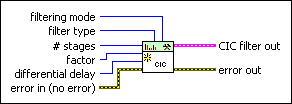DFD Build CIC Filter VI
Owning Palette: Multirate Utilities VIs
Installed With: Digital Filter Design Toolkit
Creates a cascaded integrator comb (CIC) filter.

 Place on the block diagram Place on the block diagram |  Find on the Functions palette Find on the Functions palette |
 | filtering mode specifies the processing mode of the filter that this VI creates.
| ||||||
 | filter type specifies the type of filter that this VI creates.
| ||||||
 | # stages specifies the number of stages in the CIC filter. | ||||||
 | factor specifies the sampling frequency conversion factor of the CIC filter. | ||||||
 | differential delay specifies the differential delay of the CIC filter in samples. The valid values include 1 and 2. The default is 1. | ||||||
 | error in describes error conditions that occur before this VI or function runs.
The default is no error. If an error occurred before this VI or function runs, the VI or function passes the error in value to error out. This VI or function runs normally only if no error occurred before this VI or function runs. If an error occurs while this VI or function runs, it runs normally and sets its own error status in error out. Use the Simple Error Handler or General Error Handler VIs to display the description of the error code. Use error in and error out to check errors and to specify execution order by wiring error out from one node to error in of the next node.
| ||||||
 | CIC filter out returns a new CIC multirate filter. | ||||||
 | error out contains error information. If error in indicates that an error occurred before this VI or function ran, error out contains the same error information. Otherwise, it describes the error status that this VI or function produces.
Right-click the error out front panel indicator and select Explain Error from the shortcut menu for more information about the error.
|
Examples
Refer to the following VIs for examples of using the DFD Build CIC Filter VI:
- CIC Filter Design VI: labview\examples\Digital Filter Design\Floating-Point Filters\Multirate
- Generate LabVIEW FPGA Code for Moving Average Filter VI: labview\examples\Digital Filter Design\Fixed-Point Filters\Multirate
- Create Multirate Filter VI: labview\examples\Digital Filter Design\Getting Started\Design Filters




